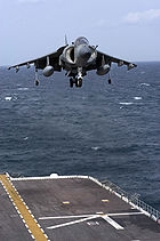
VTOL
Encyclopedia
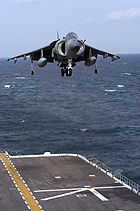
Aircraft
An aircraft is a vehicle that is able to fly by gaining support from the air, or, in general, the atmosphere of a planet. An aircraft counters the force of gravity by using either static lift or by using the dynamic lift of an airfoil, or in a few cases the downward thrust from jet engines.Although...
is one that can hover, take off and land
Takeoff and landing
Vehicles that can fly can have different ways to takeoff and land. Conventional aircraft accelerate along the ground until sufficient lift is generated for takeoff, and reverse the process to land. Some aircraft can takeoff at low speed, this a short takeoff. Some aircraft such as helicopters and...
vertically. This classification includes fixed-wing aircraft
Fixed-wing aircraft
A fixed-wing aircraft is an aircraft capable of flight using wings that generate lift due to the vehicle's forward airspeed. Fixed-wing aircraft are distinct from rotary-wing aircraft in which wings rotate about a fixed mast and ornithopters in which lift is generated by flapping wings.A powered...
as well as helicopter
Helicopter
A helicopter is a type of rotorcraft in which lift and thrust are supplied by one or more engine-driven rotors. This allows the helicopter to take off and land vertically, to hover, and to fly forwards, backwards, and laterally...
s and other aircraft with powered rotors, such as cyclogyros/cyclocopters
Cyclogyro
The cyclogyro, or cyclocopter, is an aircraft design that uses Cycloidal Rotors which consist of airfoils rotating around a horizontal axis for both lift and thrust...
and tiltrotor
Tiltrotor
A tiltrotor is an aircraft which uses a pair or more of powered rotors mounted on rotating shafts or nacelles at the end of a fixed wing for lift and propulsion, and combines the vertical lift capability of a helicopter with the speed and range of a conventional fixed-wing aircraft...
s. Some VTOL aircraft can operate in other modes as well, such as CTOL
CTOL
CTOL is an acronym for conventional take-off and landing, and is the process whereby conventional aircraft take off and land, involving the use of runways. The aircraft will taxi along the runway until its rotation speed is reached, then climb into the air...
(conventional take-off and landing), STOL
STOL
STOL is an acronym for short take-off and landing, a term used to describe aircraft with very short runway requirements.-Definitions:There is no one accepted definition of STOL and many different definitions have been used by different authorities and nations at various times and for a myriad of...
(short take-off and landing), and/or STOVL
STOVL
STOVL is an acronym for short take off and vertical landing.This is the ability of some aircraft to take off from a short runway or take off vertically if it does not have a very heavy payload and land vertically...
(short take-off and vertical landing). Others, such as some helicopters, can only operate by VTOL, due to the aircraft lacking landing gear
Landing Gear
Landing Gear is Devin the Dude's fifth studio album. It was released on October 7, 2008. It was his first studio album since signing with the label Razor & Tie. It features a high-profile guest appearance from Snoop Dogg. As of October 30, 2008, the album has sold 18,906 copies.-Track...
that can handle horizontal motion. VTOL is a subset of V/STOL
V/STOL
Vertical and/or short take-off and landing is a term used to describe aircraft that are able to take-off or land vertically or on short runways. Vertical takeoff and landing describes craft which do not require runways at all...
(vertical and/or short take-off and landing).
Besides the ubiquitous helicopter, there are currently two types of VTOL aircraft in military service: craft using a tiltrotor
Tiltrotor
A tiltrotor is an aircraft which uses a pair or more of powered rotors mounted on rotating shafts or nacelles at the end of a fixed wing for lift and propulsion, and combines the vertical lift capability of a helicopter with the speed and range of a conventional fixed-wing aircraft...
, such as the Bell
Bell Helicopter Textron
Bell Helicopter is an American rotorcraft manufacturer headquartered in Hurst, Texas, near Fort Worth. A division of Textron, Bell manufactures military helicopter and tiltrotor products in and around Fort Worth, as well as in Amarillo, Texas, and commercial rotorcraft products in Mirabel, Quebec,...
Boeing
Boeing
The Boeing Company is an American multinational aerospace and defense corporation, founded in 1916 by William E. Boeing in Seattle, Washington. Boeing has expanded over the years, merging with McDonnell Douglas in 1997. Boeing Corporate headquarters has been in Chicago, Illinois since 2001...
V-22 Osprey
V-22 Osprey
The Bell Boeing V-22 Osprey is an American multi-mission, military, tiltrotor aircraft with both a vertical takeoff and landing , and short takeoff and landing capability...
, and aircraft using directed jet thrust such as the Harrier family
Harrier Jump Jet
The Harrier, informally referred to as the Jump Jet, is a family of British-designed military jet aircraft capable of vertical/short takeoff and landing operations...
. Generally speaking, VTOL aircraft capable of V/STOL use it wherever possible, since it typically significantly increases takeoff weight, range or payload compared to pure VTOL.
Helicopter
The helicopter's form of VTOL allows the it to take off and land vertically, to hover, and to fly forwards, backwards, and laterally. These attributes allow helicopters to be used in congested or isolated areas where fixed-wing aircraftFixed-wing aircraft
A fixed-wing aircraft is an aircraft capable of flight using wings that generate lift due to the vehicle's forward airspeed. Fixed-wing aircraft are distinct from rotary-wing aircraft in which wings rotate about a fixed mast and ornithopters in which lift is generated by flapping wings.A powered...
would usually not be able to take off or land. The capability to efficiently hover for extended periods of time is due to the helicopter's relatively long, and hence efficient rotor blades, and allows a helicopter to accomplish tasks that fixed-wing aircraft and other forms of vertical takeoff and landing aircraft could not perform at least as well until 2011
Cyclogyro
The cyclogyro, or cyclocopter, is an aircraft design that uses Cycloidal Rotors which consist of airfoils rotating around a horizontal axis for both lift and thrust...
.
On the other hand, the long rotor blades restrict the maximum speed to about 250 miles per hour of at least conventional helicopters, as retreating blade stall
Retreating blade stall
Retreating blade stall is a hazardous flight condition in helicopters and other rotary wing aircraft, where the rotor blade rotating away from the direction of flight stalls. The stall is due to low relative airspeed and/or excessive angle of attack...
causes lateral instability.
History
In addition to the helicopterHelicopter
A helicopter is a type of rotorcraft in which lift and thrust are supplied by one or more engine-driven rotors. This allows the helicopter to take off and land vertically, to hover, and to fly forwards, backwards, and laterally...
, many approaches have been tried to develop practical aircraft with vertical take-off and landing capabilities. Nikola Tesla
Nikola Tesla
Nikola Tesla was a Serbian-American inventor, mechanical engineer, and electrical engineer...
patented a vertical take-off and landing vehicle concept in 1928.
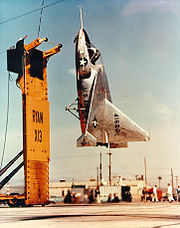
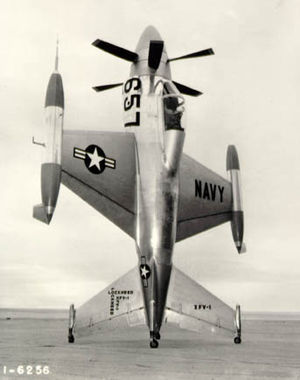
Convair
Convair was an American aircraft manufacturing company which later expanded into rockets and spacecraft. The company was formed in 1943 by the merger of Vultee Aircraft and Consolidated Aircraft, and went on to produce a number of pioneering aircraft, such as the Convair B-36 bomber, and the F-102...
and Lockheed
Lockheed Corporation
The Lockheed Corporation was an American aerospace company. Lockheed was founded in 1912 and later merged with Martin Marietta to form Lockheed Martin in 1995.-Origins:...
competed for the contract but in 1950, the requirement was revised, with a call for a research aircraft capable of eventually evolving into a VTOL ship-based convoy escort fighter. In May 1951, both Lockheed and Convair were awarded contracts in the attempt to design, construct, and test two experimental VTOL fighters. Lockheed produced the XFV
Lockheed XFV
-See also:-References:NotesCitationsBibliography* Allen, Francis J. "Bolt upright: Convair's and Lockheed's VTOL fighters". Air Enthusiast , Volume 127, January/February 2007, pp. 13–20. ISSN 0143-5450....
, and Convair producing the Convair XFY Pogo, nicknamed the "Pogo". Both experimental programs proceeded to flight status and completed test flights 1954–1955, when the contracts were cancelled. Similarily, the X-13 flew a series of test flights between 1955 and 1957, but also suffered the same fate.
Another more influential early functional contribution to VTOL was Rolls-Royce
Rolls-Royce Limited
Rolls-Royce Limited was a renowned British car and, from 1914 on, aero-engine manufacturing company founded by Charles Stewart Rolls and Henry Royce on 15 March 1906 as the result of a partnership formed in 1904....
's Thrust Measuring Rig
Rolls-Royce Thrust Measuring Rig
The Rolls-Royce Thrust Measuring Rig was a pioneering vertical take-off and landing aircraft developed by Rolls-Royce in the 1950s. The TMR used two Nene turbojet engines mounted back-to-back horizontally within a steel framework, raised upon four legs with castors for wheels...
("flying bedstead") of 1953. This led to the first VTOL engines as used in the first British VTOL aircraft, the Short SC.1
Short SC.1
|-See also:-Bibliography:* Barnes, C.H. with revisions by Derek N. James. Shorts Aircraft since 1900. London: Putnam, 1989 . ISBN 0-85177-819-4.*Illingworth J. K. B. and Chinn H.W. . London: HMSO, 1969. Retrieved: 11 December 2007....
(1957) which used 4 vertical lift engines with a horizontal one for forward thrust.
The Short SC.1
Short SC.1
|-See also:-Bibliography:* Barnes, C.H. with revisions by Derek N. James. Shorts Aircraft since 1900. London: Putnam, 1989 . ISBN 0-85177-819-4.*Illingworth J. K. B. and Chinn H.W. . London: HMSO, 1969. Retrieved: 11 December 2007....
(Belfast, Northern Ireland) was the first British fixed-wing vertical take-off and landing (VTOL) aircraft. The SC.1 was designed to study the problems with VTOL flight and the transition to and from forward flight. The SC.1 was designed to meet a Ministry of Supply (MoS) request for tender (ER.143T) for a vertical take-off research aircraft issued in September 1953. The design was accepted by the ministry and a contract was placed for two aircraft (XG900 and XG905) to meet Specification ER.143D dated 15 October 1954. The SC.1 was also equipped with the first "fly-by-wire" control system for a VTOL aircraft. This permitted three modes of control of the aerodynamic surfaces and/or the nozzle controls
The use of vertical fans driven by engines was investigated in the 1950s. The US built an aircraft where the jet exhaust drove the fans, while British projects not built included fans driven by mechanical drives from the jet engines.

Fairey Jet Gyrodyne
|-See also:-Bibliography:* Charnov, Dr. Bruce H. The Fairey Rotodyne: An Idea Whose Time Has Come – Again? Retrieved: 18 May 2007.* Green, William and Pollinger, Gerald...
, this type of aircraft later evolved into the much larger twin-engined Fairey Rotodyne
Fairey Rotodyne
The Fairey Rotodyne was a 1950s British compound gyroplane designed and built by Fairey Aviation and intended for commercial and military applications...
, that used tipjets to power the rotor on take-off and landing but which then used two Napier Eland
Napier Eland
|-See also:-Bibliography:* Gunston, Bill. World Encyclopedia of Aero Engines. Cambridge, England. Patrick Stephens Limited, 1989. ISBN 1-85260-163-9-External links:*...
turboprop
Turboprop
A turboprop engine is a type of turbine engine which drives an aircraft propeller using a reduction gear.The gas turbine is designed specifically for this application, with almost all of its output being used to drive the propeller...
s driving conventional propellers mounted on substantial wings to provide propulsion, the wings serving to unload the rotor during horizontal flight. The Rotodyne was developed to combine the efficiency of a fixed-wing aircraft at cruise with the VTOL capability of a helicopter to provide short haul airliner service from city centres to airports.
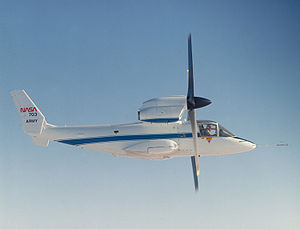
NASA
The National Aeronautics and Space Administration is the agency of the United States government that is responsible for the nation's civilian space program and for aeronautics and aerospace research...
has flown other VTOL craft such as the Bell XV-15
Bell XV-15
The Bell XV-15 was an American tiltrotor VTOL aircraft. It was the second successful experimental tiltrotor aircraft and the first to demonstrate the concept's high speed performance relative to conventional helicopters.-Early VTOL rotor aircraft:...
research craft (1977), as have the Soviet Navy
Soviet Navy
The Soviet Navy was the naval arm of the Soviet Armed Forces. Often referred to as the Red Fleet, the Soviet Navy would have played an instrumental role in a Warsaw Pact war with NATO, where it would have attempted to prevent naval convoys from bringing reinforcements across the Atlantic Ocean...
and Luftwaffe
Luftwaffe
Luftwaffe is a generic German term for an air force. It is also the official name for two of the four historic German air forces, the Wehrmacht air arm founded in 1935 and disbanded in 1946; and the current Bundeswehr air arm founded in 1956....
. Sikorsky tested an aircraft dubbed the X-Wing
Sikorsky S-72
|-See also:-External links:* * *...
, which took off in the manner of a helicopter. The rotors would become stationary in mid-flight, and function as wings, providing lift in addition to the static wings. Boeing X-50
Boeing X-50
The Boeing X-50A Dragonfly, formerly known as the Canard Rotor/Wing Demonstrator, was a gyrodyne unmanned aerial vehicle that was developed by Boeing and DARPA to demonstrate the principle that a helicopter's rotor could be stopped in flight and act as a fixed wing...
is a Canard Rotor/Wing
Canard Rotor/Wing
The Canard Rotor/Wing is a class of VTOL aircraft capable of both fixed-wing and rotary-wing flight. For vertical take-off, hovering, low-speed flight, and vertical landing, the main airfoil is spun like a helicopter's rotor by directing the exhaust from a jet engine through thrust nozzles in the...
prototype that utilizes a similar concept.
The Yakovlev Yak-38
Yakovlev Yak-38
The Yakovlev Yak-38 was Soviet Naval Aviation's first and only operational VTOL strike fighter aircraft, in addition to being its first operational carrier-based fixed-wing aircraft...
was the Soviet Navy
Soviet Navy
The Soviet Navy was the naval arm of the Soviet Armed Forces. Often referred to as the Red Fleet, the Soviet Navy would have played an instrumental role in a Warsaw Pact war with NATO, where it would have attempted to prevent naval convoys from bringing reinforcements across the Atlantic Ocean...
's VTOL aircraft for their light carriers, cargoships, and capital ships. It was developed from the Yakovlev Yak-36 experimental aircraft in the 1970s. Before the Soviet Union collapsed, a supersonic VTOL aircraft was developed as the Yak-38's successor, the Yak-141
Yakovlev Yak-141
The Yakovlev Yak-141 , also known as the Yak-41, is a supersonic vertical takeoff/landing fighter aircraft designed by Yakolev. It did not enter production.-Design and development:...
, which never went into production.


V/STOL
Vertical and/or short take-off and landing is a term used to describe aircraft that are able to take-off or land vertically or on short runways. Vertical takeoff and landing describes craft which do not require runways at all...
aircraft. Although two models (X1 and X2) were built, the project was canceled due to high costs and political problems as well as changed needs in the Luftwaffe
Luftwaffe
Luftwaffe is a generic German term for an air force. It is also the official name for two of the four historic German air forces, the Wehrmacht air arm founded in 1935 and disbanded in 1946; and the current Bundeswehr air arm founded in 1956....
and NATO. The EWR VJ 101
EWR VJ 101
-See also:-Bibliography:* Rogers, Mike. VTOL: Military Research Aircraft. New York: Orion Books, 1989. ISBN 0-517-57684-8.* Winchester, Jim. "EWR-Sud VJ 101C ". X-Planes and Prototypes. London: Amber Books Ltd., 2005. ISBN 1-904687-40-7....
C did perform free VTOL take-offs and landings, as well as test flights beyond mach 1 in the mid- and late 60s. One of the test-aircraft is preserved in the Deutsches Museum
Deutsches Museum
The Deutsches Museum in Munich, Germany, is the world's largest museum of technology and science, with approximately 1.5 million visitors per year and about 28,000 exhibited objects from 50 fields of science and technology. The museum was founded on June 28, 1903, at a meeting of the Association...
in Munich, Germany. The others were the VFW-Fokker VAK 191B
VFW VAK 191B
|-See also:-References:NotesBibliography* Jackson, Paul A. German Military Aviation 1956-1976. Hinckley, Leicestershire, UK: Midland Counties Publications, 1976. ISBN 0-904597-03-2.-External links:* * * *...
light fighter and reconnaissance aircraft, and the Dornier Do 31
Dornier Do 31
-See also:-Bibliography:*Green, William. The Observer's Book of Aircraft. London. Frederick Warne & Co. Ltd., 1968.*Jackson, Paul A. German Military Aviation 1956–1976. Hinckley, Leicestershire, UK: Midland Counties Publications, 1976. ISBN 0-904597-03-2.-External links:**...
E-3 (troop) transport.
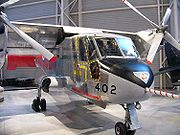
Canadair CL-84
The Canadair CL-84 "Dynavert", designated by the Canadian Forces as the CX-131, was a V/STOL turbine tilt-wing monoplane designed and manufactured by Canadair between 1964 and 1972. Only four of these experimental aircraft were built with three entering flight testing...
was a Canadian V/STOL
V/STOL
Vertical and/or short take-off and landing is a term used to describe aircraft that are able to take-off or land vertically or on short runways. Vertical takeoff and landing describes craft which do not require runways at all...
turbine tilt-wing monoplane designed and manufactured by Canadair
Canadair
Canadair Ltd. was a civil and military aircraft manufacturer in Canada. It was a subsidiary of other aircraft manufacturers, then a nationalized corporation until privatized in 1986, and became the core of Bombardier Aerospace....
between 1964 and 1972. The Canadian government ordered three updated CL-84s for military evaluation in 1968, designated the CL-84-1. From 1972 to 1974, this version was demonstrated and evaluated in the United States aboard the aircraft carriers USS Guam and USS Guadalcanal, and at various other centres. These trials involved military pilots from the United States, the United Kingdom and Canada. During testing, two of the CL-84s crashed due to mechanical failures, but no loss of life occurred as a result of these accidents. No production contracts resulted.
Aircraft designed to operate in orbital environments often utilize VTOL. An example of this type of aircraft is the LLRV. Spacecraft
Spacecraft
A spacecraft or spaceship is a craft or machine designed for spaceflight. Spacecraft are used for a variety of purposes, including communications, earth observation, meteorology, navigation, planetary exploration and transportation of humans and cargo....
typically operate in environments where runways or even a suitably flat surface for skids is nonexistent.
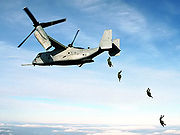
Tiltrotor
A tiltrotor is an aircraft which uses a pair or more of powered rotors mounted on rotating shafts or nacelles at the end of a fixed wing for lift and propulsion, and combines the vertical lift capability of a helicopter with the speed and range of a conventional fixed-wing aircraft...
aircraft. It has one three-bladed proprotor
Proprotor
A proprotor is a spinning airfoil that is used as both an airplane-style propeller and a helicopter-style rotor during the same flight. Proprotors are typically used on vertical takeoff and landing aircraft....
, turboprop
Turboprop
A turboprop engine is a type of turbine engine which drives an aircraft propeller using a reduction gear.The gas turbine is designed specifically for this application, with almost all of its output being used to drive the propeller...
engine, and transmission nacelle
Nacelle
The nacelle is a cover housing that holds engines, fuel, or equipment on an aircraft. In some cases—for instance in the typical "Farman" type "pusher" aircraft, or the World War II-era P-38 Lightning—an aircraft's cockpit may also be housed in a nacelle, which essentially fills the...
mounted on each wingtip. The Osprey is a multi-mission aircraft with both a vertical takeoff and landing (VTOL) and short takeoff and landing capability (STOL
STOL
STOL is an acronym for short take-off and landing, a term used to describe aircraft with very short runway requirements.-Definitions:There is no one accepted definition of STOL and many different definitions have been used by different authorities and nations at various times and for a myriad of...
). It is designed to perform missions like a conventional helicopter
Helicopter
A helicopter is a type of rotorcraft in which lift and thrust are supplied by one or more engine-driven rotors. This allows the helicopter to take off and land vertically, to hover, and to fly forwards, backwards, and laterally...
with the long-range, high-speed cruise performance of a turboprop
Turboprop
A turboprop engine is a type of turbine engine which drives an aircraft propeller using a reduction gear.The gas turbine is designed specifically for this application, with almost all of its output being used to drive the propeller...
aircraft. The FAA classifies the Osprey as a model of powered lift
Powered lift
Powered lift or powered-lift refers to a type of aircraft that can take off and land vertically and functions differently from a rotorcraft in horizontal flight....
aircraft.

Hawker P.1127
The Hawker P.1127 and the Hawker Siddeley Kestrel FGA.1 were the experimental and development aircraft that led to the Hawker Siddeley Harrier, the first vertical and/or short take-off and landing jet fighter-bomber...
, which became subsequently the Kestrel and then entered production as the Hawker Siddeley Harrier, though the supersonic Hawker Siddeley P.1154
Hawker Siddeley P.1154
The Hawker Siddeley P.1154 was a planned supersonic vertical/short take-off and landing fighter aircraft designed by Hawker Siddeley Aviation . Developed alongside the subsonic and smaller Hawker Siddeley P.1127/Kestrel, the P.1154 was derived from the P.1150. The P.1150 proposal did not meet NATO...
was canceled in 1965. The French in competition with the P.1154 had developed a version of the Dassault Mirage III
Dassault Mirage III
The Mirage III is a supersonic fighter aircraft designed by Dassault Aviation during the late 1950s, and manufactured both in France and a number of other countries. It was a successful fighter aircraft, being sold to many air forces around the world and remaining in production for over a decade...
capable of attaining Mach
Mach number
Mach number is the speed of an object moving through air, or any other fluid substance, divided by the speed of sound as it is in that substance for its particular physical conditions, including those of temperature and pressure...
1. The Dassault Mirage IIIV
Dassault Mirage IIIV
|-See also:-Bibliography:* Breffort, Dominique and Andre Jouineau. "The Mirage III, 5, 50 and derivatives from 1955 to 2000." Planes and Pilots 6. Paris: Histoire et Collections, 2004. ISBN 2-913903-92-4....
achieved transition from vertical to horizontal flight in March 1966, reaching Mach 1.3 in level flight a short time later.
V/STOL
The Harrier is usually flown in STOVLSTOVL
STOVL is an acronym for short take off and vertical landing.This is the ability of some aircraft to take off from a short runway or take off vertically if it does not have a very heavy payload and land vertically...
mode which enables it to carry a higher fuel or weapon load over a given distance.
In V/STOL the VTOL aircraft moves horizontally along the runway before taking off using vertical thrust. This gives aerodynamic lift as well as thrust lift and permits taking off with heavier loads and is more efficient.
When landing the aircraft is much lighter due to the loss of propellant weight and a vertical landing is much easier to perform.
Now retired from British Royal Navy
Royal Navy
The Royal Navy is the naval warfare service branch of the British Armed Forces. Founded in the 16th century, it is the oldest service branch and is known as the Senior Service...
service, the Indian Navy
Indian Navy
The Indian Navy is the naval branch of the armed forces of India. The President of India serves as the Commander-in-Chief of the Navy. The Chief of Naval Staff , usually a four-star officer in the rank of Admiral, commands the Navy...
operates Sea Harriers mainly from its aircraft carrier
Aircraft carrier
An aircraft carrier is a warship designed with a primary mission of deploying and recovering aircraft, acting as a seagoing airbase. Aircraft carriers thus allow a naval force to project air power worldwide without having to depend on local bases for staging aircraft operations...
INS Viraat
INS Viraat
INS Viraat is a Centaur class aircraft carrier currently in service with the Indian Navy. INS Viraat is the flagship of the Indian Navy, the oldest carrier in service and one of two aircraft carriers in the Indian Ocean Region.The Viraat was completed and commissioned in 1959 as the Royal Navy's...
. The latest version of the Harrier, the BAE Harrier II is operated by the British Royal Air Force
Royal Air Force
The Royal Air Force is the aerial warfare service branch of the British Armed Forces. Formed on 1 April 1918, it is the oldest independent air force in the world...
and Royal Navy
Royal Navy
The Royal Navy is the naval warfare service branch of the British Armed Forces. Founded in the 16th century, it is the oldest service branch and is known as the Senior Service...
. The United States Marine Corps, and the Italian and Spanish Navies use the AV-8B Harrier II
AV-8B Harrier II
The McDonnell Douglas AV-8B Harrier II is a second-generation vertical/short takeoff and landing ground-attack aircraft. An Anglo-American development of the British Hawker Siddeley Harrier, the Harrier II is the final member of the Harrier family that started with the Hawker Siddeley P.1127 in...
, an equivalent derivative of the Harrier II. The Harrier II/AV-8 will be replaced in the air arms of the US and UK by a STOVL variant of the Lockheed Martin F-35 Lightning II.
See also
- List of VTOL aircraft
- List of Tesla patents
- McDonnell Douglas DC-XMcDonnell Douglas DC-XThe DC-X, short for Delta Clipper or Delta Clipper Experimental, was an unmanned prototype of a reusable single stage to orbit launch vehicle built by McDonnell Douglas in conjunction with the United States Department of Defense's Strategic Defense Initiative Organization from 1991 to 1993...
- Military disc shaped aircraft
- Mono tiltrotorMono tiltrotorThe Baldwin Mono Tiltrotor project is a research effort into a tiltrotor aircraft that uses only one rotor. Like other tiltrotor configurations, the mono tiltrotor combines the vertical lift capability and structural efficiency of a helicopter with the speed and range of an fixed-wing...
- Peter BielkowiczPeter BielkowiczPeter Bielkowicz was a physicist. He worked on designing the Apollo Lunar Module and many other projects. He developed and taught courses in many fields, including aerodynamics, flight mechanics, ballistics, mathematics, and astrodynamics. He created AFIT's first courses in space mechanics and...
- Powered liftPowered liftPowered lift or powered-lift refers to a type of aircraft that can take off and land vertically and functions differently from a rotorcraft in horizontal flight....
- ProprotorProprotorA proprotor is a spinning airfoil that is used as both an airplane-style propeller and a helicopter-style rotor during the same flight. Proprotors are typically used on vertical takeoff and landing aircraft....
- PtolPTOLPTOL is an evolving term describing special take-off and landing capabilities of Unmanned aerial vehicles and other aircraft....
- Quad (rocket)Quad (rocket)In rocketry, the Armadillo aerospace Quad vehicle is a computer controlled VTVL rocket that is used to compete in the Lunar Lander Challenge.-General description:...
- Reusable Vehicle TestingReusable Vehicle TestingThe Reusable Vehicle Testing project was conducted by the Japanese Space Agency from 1998 until 2003. The project involved a series of experimental vehicles to test repeated flights of a reusable rocket. Four complete vehicles were developed during the project...
project of the Japanese Space Agency JAXA - STOLSTOLSTOL is an acronym for short take-off and landing, a term used to describe aircraft with very short runway requirements.-Definitions:There is no one accepted definition of STOL and many different definitions have been used by different authorities and nations at various times and for a myriad of...
- TailsitterTailsitterA tailsitter is a type of VTOL aircraft that launches and lands on its tail. One of the most famous examples of this type of aircraft is the Ryan X-13 Vertijet. Among the propeller-driven versions were the Lockheed XFV, and the Convair XFY Pogo. Studies and wind tunnel models were made of a...
- TiltrotorTiltrotorA tiltrotor is an aircraft which uses a pair or more of powered rotors mounted on rotating shafts or nacelles at the end of a fixed wing for lift and propulsion, and combines the vertical lift capability of a helicopter with the speed and range of a conventional fixed-wing aircraft...
- TiltjetTiltjetA tiltjet aircraft is similar in concept to a tiltrotor design. Whereas a tiltrotor utilises rotors, the tiltjet employs jet engines with the entire propulsion system being rotated from the from axial to dorsal in order to achieve a transition from hover or vertical flight to horizontal. They are...
- TiltwingTiltwingA tiltwing aircraft features a wing that is horizontal for conventional forward flight and rotates up for vertical takeoff and landing. It is similar to the tiltrotor design where only the propeller and engine rotate. Tiltwing aircraft are typically fully capable of VTOL operations.The tiltwing...
- VSTOL

